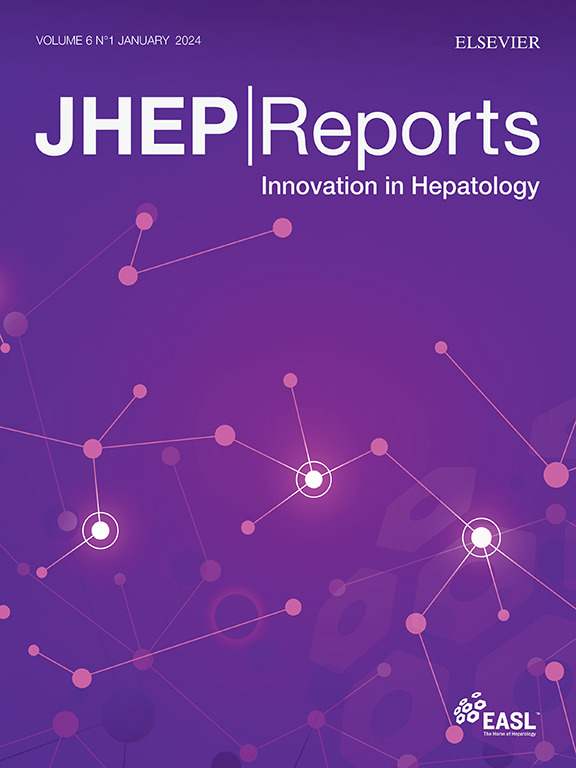Comparative evaluation of multimarker algorithms for early-stage HCC detection in multicenter prospective studies
IF 9.5
1区 医学
Q1 GASTROENTEROLOGY & HEPATOLOGY
引用次数: 0
Abstract
Background & Aims
We compared the clinical performance of the novel GAAD (gender [biological sex], age, alpha-fetoprotein [AFP], des-gamma carboxyprothrombin [DCP]) and GALAD (gender [biological sex], age, AFP, Lens culinaris agglutinin-reactive AFP [AFP-L3], DCP) algorithms to deduce the clinical utility of AFP-L3 for detecting early-stage hepatocellular carcinoma (HCC) from chronic liver disease (CLD).
Methods
An algorithm development study (STOP-HCC-ARP) and clinical validation study (STOP-HCC-MCE) were conducted, recruiting adult participants with HCC (confirmed by radiology or pathology) or CLD in an international, multicenter, case-control design. Serum biomarkers were measured using Elecsys assays (GAAD and GALAD [Cobas]) or μTASWAKO assays (GALAD [μTASWAKO]) while blinded to case/control status.
Results
In STOP-HCC-ARP (algorithm development cohort), 1,006 patients {297 HCC (41.4% early-stage [Barcelona Clinic Liver Cancer {BCLC} 0/A) and 709 CLD} were included. Area under the curve (AUCs) for discriminating between early-stage HCC vs. CLD were 91.4%, 91.4%, and 90.8% for GAAD (Cobas), GALAD (Cobas), and GALAD (μTASWAKO), respectively. The clinical validation cohort of STOP-HCC-MCE comprised 1,142 patients, (366 HCC cases [48% early-stage], 468 specificity samples and 302 CLD); AUCs for GAAD (Cobas), GALAD (Cobas), and GALAD (μTASWAKO) for discriminating between early-stage HCC vs. CLD were 91.4%, 91.5%, and 91.0%, respectively; AUCs were 94.7–95.0% for all-stage HCC. The GAAD and GALAD algorithms demonstrated similar good performance regardless of disease etiology, presence of cirrhosis, geographical region, and within pan-tumor specificity panels (p <0.001).
Conclusions
GAAD (Cobas) demonstrated good clinical performance, similar to GALAD (Cobas and μTASWAKO) algorithms, in differentiating HCC and CLD controls, across all disease stages, etiologies, and regions; therefore, AFP-L3 may have a negligible role in GALAD for HCC surveillance.
Impact and implications
To improve the detection of early-stage hepatocellular carcinoma (HCC) from benign chronic liver disease (CLD), algorithms combining demographic characteristics and serum biomarkers, such as GAAD and GALAD, have been developed. GAAD combines gender (biological sex), age, alpha-fetoprotein (AFP), des-gamma carboxy-prothrombin (DCP); GALAD combines the same characteristics and biomarkers as GAAD with the addition of Lens culinaris agglutinin-reactive AFP (AFP-L3). Changing disease etiologies and treatment paradigms have raised questions regarding the utility of AFP-L3 in HCC surveillance. Our work demonstrates that the GAAD (Cobas) algorithm demonstrated good clinical performance and was as sensitive and specific as the GALAD (Cobas) and GALAD (μTASWAKO) algorithms in differentiating HCC and CLD controls, across all disease stages, etiologies, and geographical regions; therefore, AFP-L3 may have a negligible role in HCC detection. Our study provides supporting evidence that in participants with CLD undergoing guideline-directed HCC surveillance, the GAAD (Cobas) algorithm may be used as an effective method for the detection of HCC, potentially resulting in improved patient outcomes.

多中心前瞻性研究中早期HCC检测的多标记算法的比较评价
背景与目的:我们比较了新型GAAD(性别[生理性别]、年龄、甲胎蛋白[AFP]、去- γ羧凝血酶原[DCP])和GALAD(性别[生理性别]、年龄、AFP、Lens culinaris凝集素反应性AFP [AFP- l3]、DCP)算法的临床表现,以推断AFP- l3在慢性肝病(CLD)早期肝细胞癌(HCC)检测中的临床应用价值。方法:进行算法开发研究(STOP-HCC-ARP)和临床验证研究(STOP-HCC-MCE),在国际、多中心、病例对照设计中招募HCC(经放射学或病理证实)或CLD的成年参与者。采用Elecsys测定法(GAAD和GALAD [Cobas])或μTASWAKO测定法(GALAD [μTASWAKO])测定血清生物标志物,同时对病例/对照状态进行盲法测定。结果:在STOP-HCC-ARP(算法开发队列)中,共纳入1006例患者{297例HCC(41.4%)早期[巴塞罗那临床肝癌{BCLC} 0/A]和709例CLD}。GAAD (Cobas)、GALAD (Cobas)和GALAD (μTASWAKO)鉴别早期HCC与CLD的曲线下面积(auc)分别为91.4%、91.4%和90.8%。STOP-HCC-MCE临床验证队列包括1142例患者,其中366例HCC(48%早期),468例特异性样本和302例CLD;GAAD (Cobas)、GALAD (Cobas)和GALAD (μTASWAKO)鉴别早期HCC与CLD的auc分别为91.4%、91.5%和91.0%;所有分期HCC的auc为94.7% -95.0%。结论:GAAD (Cobas)与GALAD (Cobas和μTASWAKO)算法在所有疾病分期、病因和地区鉴别HCC和CLD对照方面表现出良好的临床表现,与GALAD (Cobas和μTASWAKO)算法相似;因此,AFP-L3在GALAD监测HCC中的作用可以忽略不计。影响和意义:为了提高良性慢性肝病(CLD)早期肝细胞癌(HCC)的检测,研究人员开发了结合人口统计学特征和血清生物标志物(如GAAD和GALAD)的算法。GAAD结合了性别(生理性别)、年龄、甲胎蛋白(AFP)、去γ羧基凝血酶原(DCP);GALAD结合了与GAAD相同的特征和生物标志物,并添加了Lens culinaris凝集素反应性AFP (AFP- l3)。不断变化的疾病病因和治疗模式对AFP-L3在HCC监测中的应用提出了质疑。我们的工作表明,在所有疾病分期、病因和地理区域,GAAD (Cobas)算法在区分HCC和CLD对照方面表现出良好的临床表现,与GALAD (Cobas)和GALAD (μTASWAKO)算法一样敏感和特异性;因此,AFP-L3在HCC检测中的作用可以忽略不计。我们的研究提供了支持性证据,证明在接受指南指导的HCC监测的CLD参与者中,GAAD (Cobas)算法可能被用作检测HCC的有效方法,可能会改善患者的预后。
本文章由计算机程序翻译,如有差异,请以英文原文为准。
求助全文
约1分钟内获得全文
求助全文
来源期刊

JHEP Reports
GASTROENTEROLOGY & HEPATOLOGY-
CiteScore
12.40
自引率
2.40%
发文量
161
审稿时长
36 days
期刊介绍:
JHEP Reports is an open access journal that is affiliated with the European Association for the Study of the Liver (EASL). It serves as a companion journal to the highly respected Journal of Hepatology.
The primary objective of JHEP Reports is to publish original papers and reviews that contribute to the advancement of knowledge in the field of liver diseases. The journal covers a wide range of topics, including basic, translational, and clinical research. It also focuses on global issues in hepatology, with particular emphasis on areas such as clinical trials, novel diagnostics, precision medicine and therapeutics, cancer research, cellular and molecular studies, artificial intelligence, microbiome research, epidemiology, and cutting-edge technologies.
In summary, JHEP Reports is dedicated to promoting scientific discoveries and innovations in liver diseases through the publication of high-quality research papers and reviews covering various aspects of hepatology.
 求助内容:
求助内容: 应助结果提醒方式:
应助结果提醒方式:


